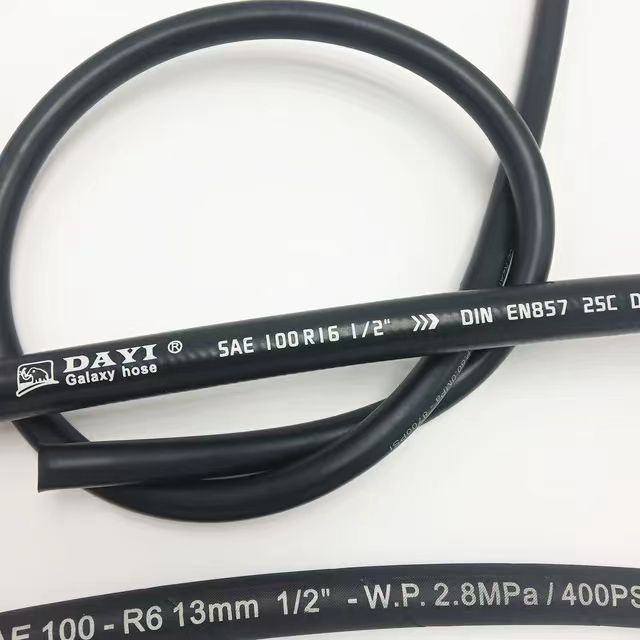335345435
Nov . 05, 2024 02:27 Back to list
fiber braid hydraulic hose
The Importance of Fiber Braid Hydraulic Hoses in Modern Applications
In the world of hydraulics, the importance of durability and functionality cannot be overstated. One of the most critical components found in hydraulic systems is the hydraulic hose, which transmits hydraulic fluid under high pressure. Among the various types of hydraulic hoses available, fiber braid hydraulic hoses stand out for their impressive strength, flexibility, and reliability.
What is a Fiber Braid Hydraulic Hose?
A fiber braid hydraulic hose consists of a flexible inner tube that carries the hydraulic fluid, surrounded by multiple layers of reinforcement, typically made from synthetic fibers. These fibers, which include materials like polyester or nylon, are woven together to create a braid that enhances the hose's resistance to high pressures and extreme conditions. The outer cover of the hose is designed to protect it from abrasion, chemicals, and environmental factors, ensuring longevity and superior performance in various applications.
Advantages of Fiber Braid Hydraulic Hoses
1. High Pressure Resistance One of the most significant advantages of fiber braid hydraulic hoses is their ability to withstand high pressures. The braided design distributes stress evenly across the circumference of the hose, preventing failure under pressure. This makes them suitable for demanding hydraulic applications where pressure fluctuations can occur.
2. Flexibility and Adaptability Fiber braid hoses are remarkably flexible, allowing them to be maneuvered around tight corners and complex machinery without compromising performance. This flexibility is crucial in mobile applications, such as construction equipment and agricultural machinery, where hoses must navigate narrow spaces.
fiber braid hydraulic hose

3. Lightweight Construction Compared to other types of hydraulic hoses reinforced with steel wire, fiber braid hoses are lighter. This feature is particularly advantageous in reducing the overall weight of hydraulic systems, which can lead to improved fuel efficiency and reduced wear on machinery.
4. Resistance to Abrasion and Chemicals The outer layer of fiber braid hydraulic hoses is typically engineered to resist abrasion and exposure to various chemicals. This means that they can withstand harsh environments, making them ideal for use in industries such as mining, manufacturing, and agriculture, where hoses are exposed to challenging conditions.
5. Cost-Effective Solution While the initial cost of fiber braid hydraulic hoses may vary depending on the specifications, their longevity and low maintenance needs often lead to cost savings over time. Their durability means fewer replacements and repairs, reducing operational downtime.
Applications of Fiber Braid Hydraulic Hoses
Fiber braid hydraulic hoses find applications across a variety of sectors. In the construction industry, they are used in excavators, bulldozers, and cranes, where reliable hydraulic performance is essential. In agriculture, these hoses are used in tractors and harvesters, providing efficient power transmission for various implements. Additionally, they are an integral component in manufacturing processes, automotive systems, and even aerospace technologies, where precision and reliability cannot be compromised.
Conclusion
Fiber braid hydraulic hoses are a testament to advancements in materials science and engineering. Their strength, flexibility, and resistance to harsh conditions make them indispensable in a wide range of hydraulic applications. As industries continue to evolve and demand higher performance from their hydraulic systems, fiber braid hydraulic hoses will undoubtedly play a crucial role in meeting these challenges. By investing in quality hydraulic hoses, businesses can ensure operational efficiency, safety, and reliability in their systems, ultimately contributing to their success in competitive markets.
-
SAE 100 R17 Black Smooth Cover Hydraulic Hose
NewsMar.07,2025
-
SAE 100 R17 Black Smooth Cover Hydraulic Hose
NewsMar.07,2025
-
SAE 100 R17 Black Smooth Cover Hydraulic Hose
NewsMar.07,2025
-
SAE 100 R17 Black Smooth Cover Hydraulic Hose
NewsMar.07,2025
-
SAE 100 R17 Black Smooth Cover Hydraulic Hose
NewsMar.07,2025
-
steel wire braided hydraulic hose
NewsMar.07,2025



